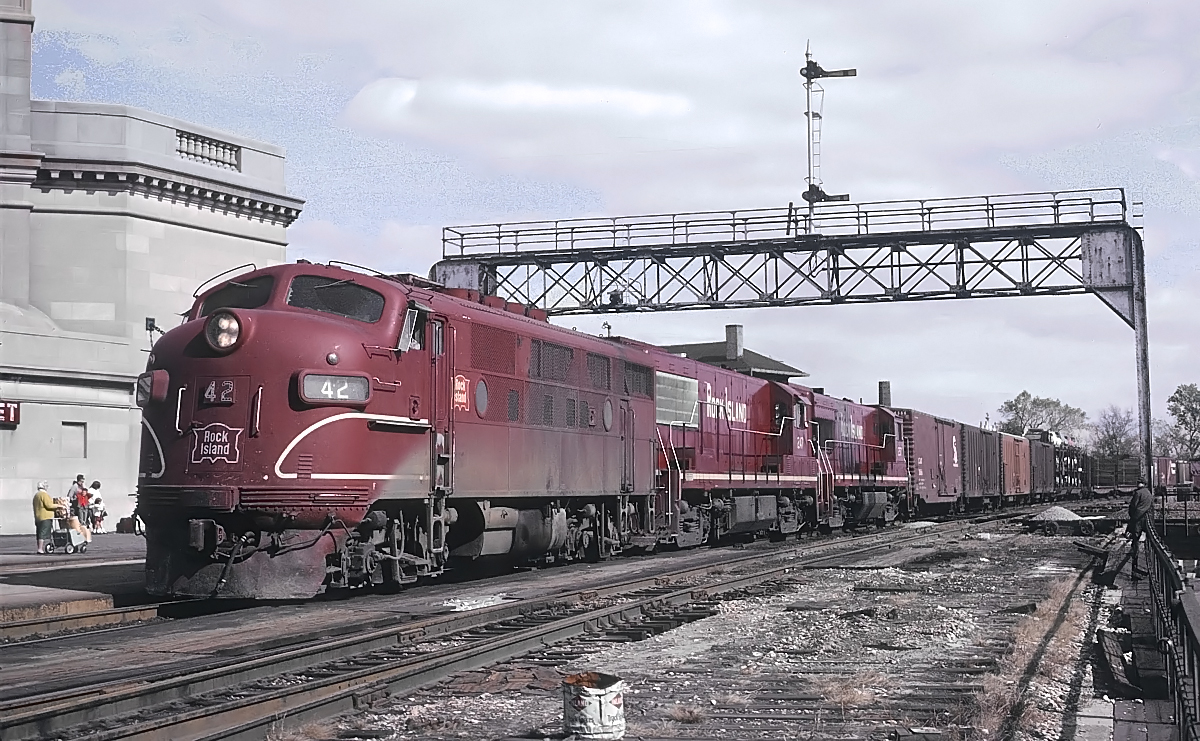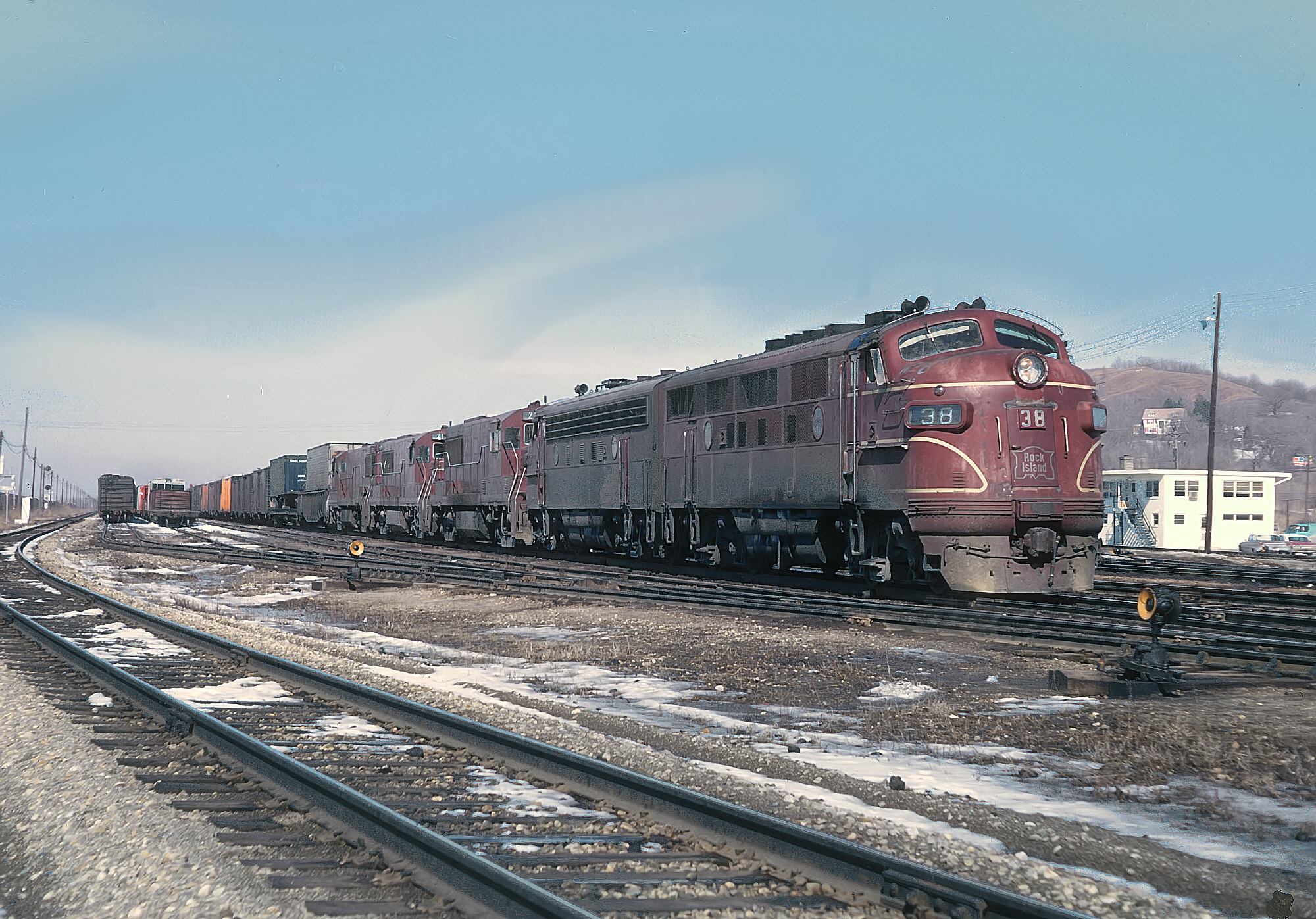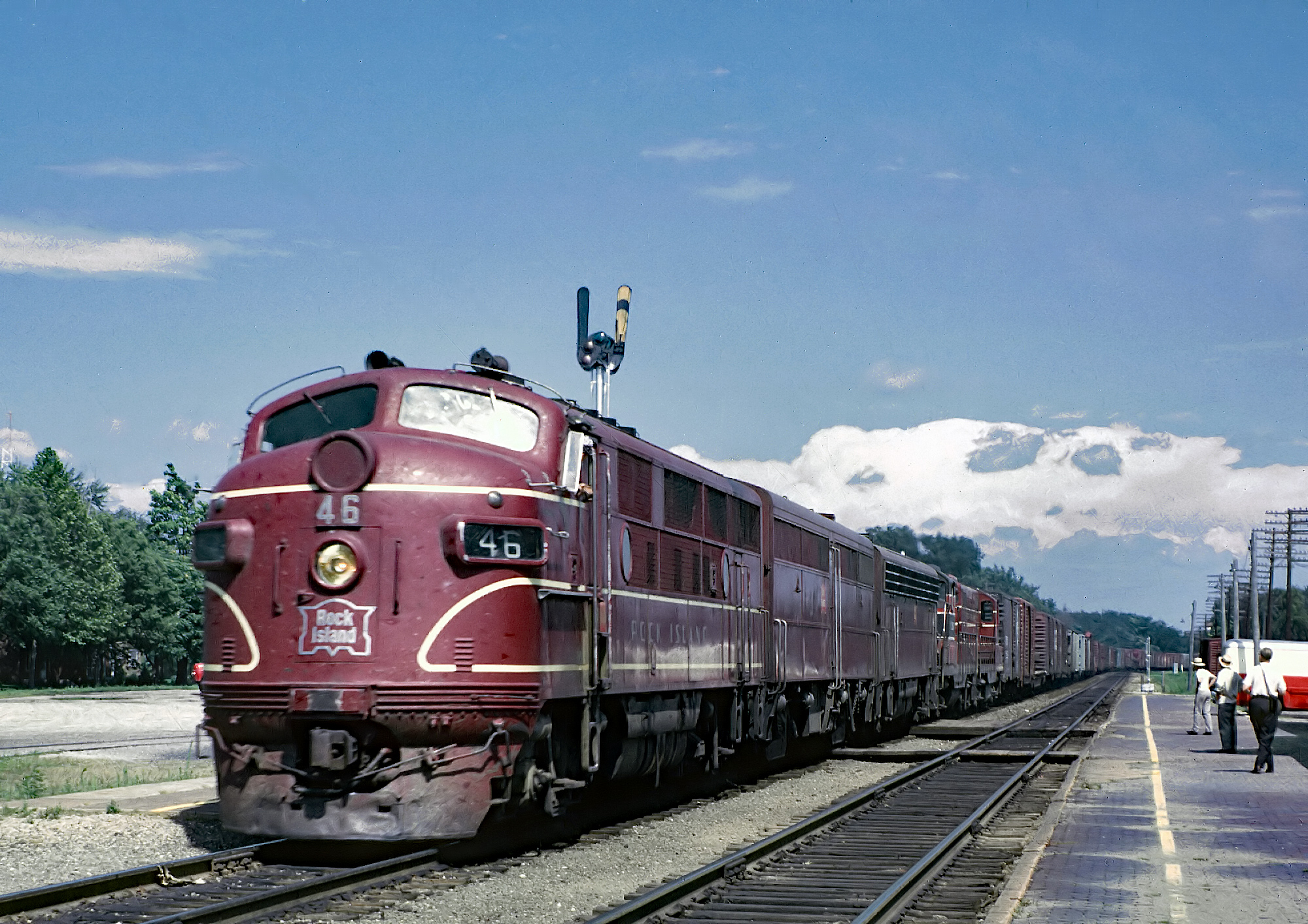EMD "F2" Locomotives: Specs, Roster, History
Last revised: December 16, 2024
By: Adam Burns
The F2 enjoyed the shortest domestic production run in Electro-Motive's F series catalog, built only from July to November, 1947. However, it was never meant to be a long-running model, only a temporary measure until the builder had worked out the problems with its latest generator.
The F2's brief catalog saw sales reach only slightly more than 100 units (A's and B's), among a handful of railroads.
These companies included Atlantic Coast Line; Atlantic & East Carolina; Alabama Great Southern (Southern Railway); Boston & Maine; Chicago, Burlington & Quincy; Minneapolis & St. Louis; Rock Island; New York Central; and Ferrocarriles Nacionales de México.
The Rock Island, ACL, and Boston & Maine were particularly big buyers, acquiring at least a dozen units each until production switched to the F3. Unfortunately, due to the locomotive's rarity, in addition to its status as a transition model, no examples were preserved.
Photos
 Rock Island F2A #42 leads a westbound freight past Joliet Union Station on October 16, 1966. Roger Puta photo.
Rock Island F2A #42 leads a westbound freight past Joliet Union Station on October 16, 1966. Roger Puta photo.Overview
Electro-Motive's FT changed railroading forever by radically improving operations; the diesel could operate further between refueling stops, required less maintenance, and pull greater tonnage between major overhauls.
EMD ultimately sold 1.096 units between 1939 and 1945, and would have enjoyed even higher sales if not for wartime restrictions. With strong demand after World War II, the builder intended to release its latest model offering greater horsepower.
However, as Brian Solomon notes in his book, "Electro-Motive: E Units and F Units," production problems with EMD's latest D12 generator pushed back mass production on the model.
As a result, the builder released a stop gap model, the F2; it featured the latest prime mover (567B) and an updated carbody but featured a variant of the FT's D8 generator. Because of this, it was limited to 1,350 horsepower.
 A rare Rock Island F2A, #38, and several other units, at Council Bluffs, Iowa in March, 1965. Rick Burn photo.
A rare Rock Island F2A, #38, and several other units, at Council Bluffs, Iowa in March, 1965. Rick Burn photo.Externally, the F2 continued to carry the classic "bulldog" nose and streamlined carbody (although it slightly changed the steel sheathing around the front truck).
However, Electro-Motive did make some minor, visual changes in this area such as the port holes' spacing with only three incorporated into the carbody instead of the closely spaced four on the FT.
The builder also employed four exhaust fan housings on the roof and made the fuel tank more streamlined with the rest of the carbody.
Aside from these differences the F2 varied little from the FT sporting the same frame and remained at around 50-feet in length. Finally, its weight of 115 tons remained the same as the former model.
Data Sheet and Specifications
| Entered Production | 7/1946 (Rock Island #49) |
| Years Produced | 7/1946 - 11/1946 |
| Engine | 567B |
| Engine Builder | GM |
| Horsepower | 1350 |
| RPM | 800 |
| Cylinders | 16 |
| Length, Over Couplers (A Unit) | 50' 8" |
| Length, Over Couplers (B Unit) | 50' 0" |
| Height (Top Of Rail To Top Of Roof) | 14' ½" |
| Height (Top Of Rail To Top Of Horn) | 15' 0" |
| Width | 10' 7" |
| Weight (A Unit) | 230,000 Lbs |
| Weight (B Unit) | 228,000 Lbs |
| Fuel Capacity | 1,200 Gallons |
| Air Compressor | Gardner-Denver |
| Air Compressor Model | WBO |
| Air Brake Manufacturer | Westinghouse |
| Air Brake Schedule | 24RL |
| Trucks | B-B |
| Truck Type | Blomberg |
| Truck Wheelbase | 9' |
| Wheel Size | 40" |
| Traction Motors | D7b (4), GM |
| Primary Generator | D8, GM |
| Auxiliary Generator | Delco (A8102) |
| Alternator | D14 |
| MU (Multiple-Unit) | Yes |
| Dynamic Brakes | Yes |
| Gear Ratio Options | 65:12, 62:15, 61:16, 60:17, 59:18, 58:19, 57:20, 56:21 |
| Tractive Effort (Continuous) | 52,400 Lbs (65:12); 40,000 Lbs (62:15); 37,000 Lbs (61:16); 34,000 Lbs (60:17); 32,000 Lbs (59:18); 29,500 Lbs (58:19); 27,500 Lbs (57:20); 25,500 Lbs (56:21) |
| Top Speed | 55 mph, 65 mph, 71 mph, 77 mph, 83 mph, 95 mph, 102 mph |
Production Roster
F2A
Total Built = 60
| Owner | Road Number | Serial Number | Order Number | Completion Date |
|---|---|---|---|---|
| Rock Island | 49-38 (Reversed) | 2637-2648 | E617 | 7/1946 |
| Chicago, Burlington & Quincy | 150A, 155C, 151A, 156C, 152A, 157C, 153A, 158C, 154A, 159C | 3018-3027 | E648 | 7/1946 |
| Boston & Maine | 4250-4264 | 3070-3084 | E649 | 7/1946 - 8/1946 |
| Boston & Maine | 4224A-4226A | 3085-3087 | E725 | 10/1946 |
| Southern (Alabama Great Southern) | 6700-6701 | 3376-3377 | E675 | 7/1946 |
| Atlantic & East Carolina | 400-401 | 3419-3420 | E681 | 7/1946 |
| Atlantic Coast Line | 324-335 | 3437-3448 | E684 | 8/1946 - 10/1946 |
| Minneapolis & St Louis | 147A, 147C | 3660-3661 | E702 | 11/1946 |
| New York Central | 1604-1605 | 3771-3772 | E721 | 7/1946 |
F2B
Total Built = 16
| Owner | Road Number | Serial Number | Order Number | Completion Date |
|---|---|---|---|---|
| Boston & Maine | 4224B-4226B | 3088-3090 | E725 | 10/1946 |
| Atlantic Coast Line | 324B-335B | 3449-3460 | E684 | 8/1946 - 10/1946 |
| Minneapolis & St Louis | 147B | 3662 | E702 | 11/1946 |
Export
F2A
Total Built = 14
| Owner | Road Number | Serial Number | Order Number | Completion Date |
|---|---|---|---|---|
| National Railways of Mexico ( Ferrocarriles Nacionales de México) | 6200A-6206A | 3528-3534 | E691 | 8/1946 - 10/1946 |
| National Railways of Mexico ( Ferrocarriles Nacionales de México) | 6207A-6213A | 3690-3696 | E707 | 10/1946 |
F2B
Total Built = 14
| Owner | Road Number | Serial Number | Order Number | Completion Date |
|---|---|---|---|---|
| National Railways of Mexico ( Ferrocarriles Nacionales de México) | 6200B-6206B | 3535-3541 | E691 | 8/1946 - 10/1946 |
| National Railways of Mexico ( Ferrocarriles Nacionales de México) | 6207B-6213B | 3697-3703 | E707 | 10/1946 |
 A rare Rock Island F2A (#46), an FB-1 (Alco), and a trio of other first-generation EMD products lead a long freight train westbound past the station at Ottawa, Illinois on a July afternoon in 1963. Roger Puta photo.
A rare Rock Island F2A (#46), an FB-1 (Alco), and a trio of other first-generation EMD products lead a long freight train westbound past the station at Ottawa, Illinois on a July afternoon in 1963. Roger Puta photo.During the F2's production, Electro-Motive had not yet established its Canadian division, General Motors Diesel. The subsidiary was established in 1950 with the first locomotive rolling out of its London, Ontario plant in August (Toronto, Hamilton & Buffalo GP7 #71).
This changed, however, during the F7's production when Canadian National, Canadian Pacific, and even the Wabash purchased the model (for its southern Ontario line).
The first F7's began rolling out of the London plant in December, 1950 (Wabash). Many F2s remained in service for many years but today, as mentioned above, all were scrapped before any could be saved for posterity.
Sources
- Marre, Louis A. Diesel Locomotives: The First 50 Years, A Guide To Diesels Built Before 1972. Milwaukee: Kalmbach Publishing Company, 1995.
- Pinkepank, Jerry A. Diesel Spotter's Guide. Milwaukee: Kalmbach Publishing Company, 1967.
- Schafer, Mike. Vintage Diesel Locomotives. Osceola: MBI Publishing, 1998.
- Solomon, Brian. EMD Locomotives. Minneapolis: MBI Publishing Company, 2006.
- Solomon, Brian. Electro-Motive E-Units and F-Units: The Illustrated History of North America's Favorite Locomotives. Minneapolis: Voyageur Press, 2011.
